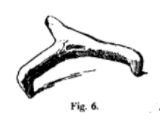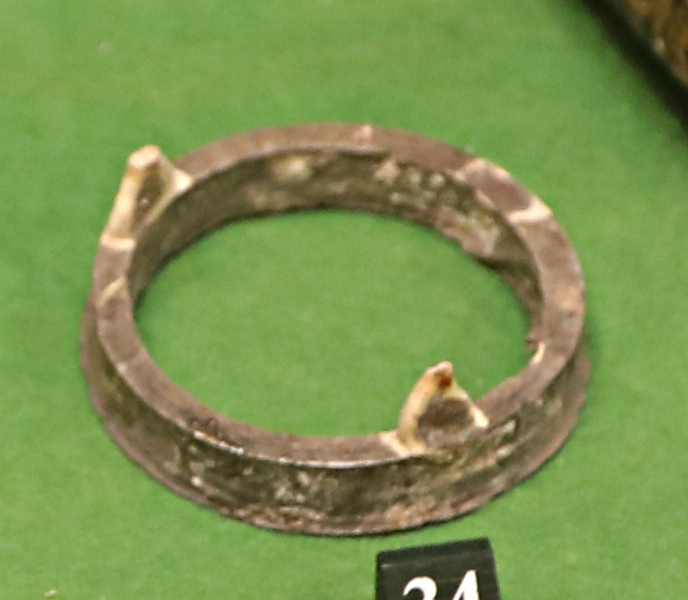Stilt (ceramics) on:
[Wikipedia]
[Google]
[Amazon]


 Stilts are small supports used when firing glazed
Stilts are small supports used when firing glazed
 Ring stilts, which consist of a ring with three raised points of clay placed at equal distances around the rim, were in use in the second half of the 18th century.
Ring stilts, which consist of a ring with three raised points of clay placed at equal distances around the rim, were in use in the second half of the 18th century.
 A stilt has been found at a Roman kiln site near
A stilt has been found at a Roman kiln site near

ceramic
A ceramic is any of the various hard, brittle, heat-resistant and corrosion-resistant materials made by shaping and then firing an inorganic, nonmetallic material, such as clay, at a high temperature. Common examples are earthenware, porcelain ...
s to stop the melting glaze from fusing them to each other or the kiln. Stilts are a form of kiln furniture
Kiln furniture are devices and implements inside furnaces used during the heating of manufactured individual pieces, such as pottery or other ceramic or metal components.
Materials
Commonly used materials are cordierite (up to 1275 °C), mull ...
. Their presence in archaeological sites, where they may be known as pernette, along with other kiln furniture such as saggar
A saggar (also misspelled as sagger or segger) is a type of kiln furniture. It is a ceramic boxlike container used in the firing of pottery to enclose or protect ware being fired inside a kiln. Traditionally, saggars were made primarily from fi ...
s and kiln bar
A kiln is a thermally insulated chamber, a type of oven, that produces temperatures sufficient to complete some process, such as hardening, drying, or chemical changes. Kilns have been used for millennia to turn objects made from clay int ...
s can be used to support a case for local production. Some potters avoid the need for stilts by not glazing the bottom of their products. This is known as dry footing.
History
Various types of stilts have been developed over the centuries:Tripod stilt
The tripod stilt, which has three legs with a raised point on each end, appears to have been developed in China at least as far back as the third century AD. Tripod stilts have been found during excavations in Ur. It was adopted by the Islamic world in the 9th century AD and was later adopted by the Byzantines around the start of the 13th century. The use of this stilt can be deduced from damage to the glaze where the three raised points were in direct contact with it. A similar type of stilt appears to have been used in the Staffordshire area and perhaps Scotland between the 1760s and 1850s.Ring stilt
Crown stilt
Crown stilts were in use during much the same time period as ring stilts.Other types
 A stilt has been found at a Roman kiln site near
A stilt has been found at a Roman kiln site near Holt, Wrexham County Borough
Holt is a medieval market town and community in Wrexham County Borough, Wales. It is situated on the border with England and in the historic county of Denbighshire. Holt Castle was begun by Edward I shortly after the English invasion of Wa ...
dating to around the first or second century AD. It was designed to be used within a saggar
A saggar (also misspelled as sagger or segger) is a type of kiln furniture. It is a ceramic boxlike container used in the firing of pottery to enclose or protect ware being fired inside a kiln. Traditionally, saggars were made primarily from fi ...
and has clay pads supporting it within the saggar.
Archaeology
In archaeology, they may be upside-down baked clay tripods, leaving characteristic marks at the bottoms of the pottery/porcelain. They expose the bottom of the fired piece to the full heat and prevent the pieces from sticking to each other.Manufacture
In the 19th century centralised industrial production of molded three-arm stilts began common in the UK with Staffordshire exporting them to other parts of the country. Some of the manufactures appear to have used distinctive mold designs. Stilts are still used and produced today and are marketed by pottery suppliers.Non-pottery uses
Some researchers have used kiln stilts as a settlement substrate for coral larva including those of the species ''Dendrogyra cylindrus
Pillar coral (''Dendrogyra cylindrus'') is a hard coral (order Scleractinia) found in the western Atlantic Ocean and the Caribbean Sea. It is the only species in the monotypic genus ''Dendrogyra''. It is a digitate coral -that is, it resembles fi ...
''.
References
Pottery {{Pottery